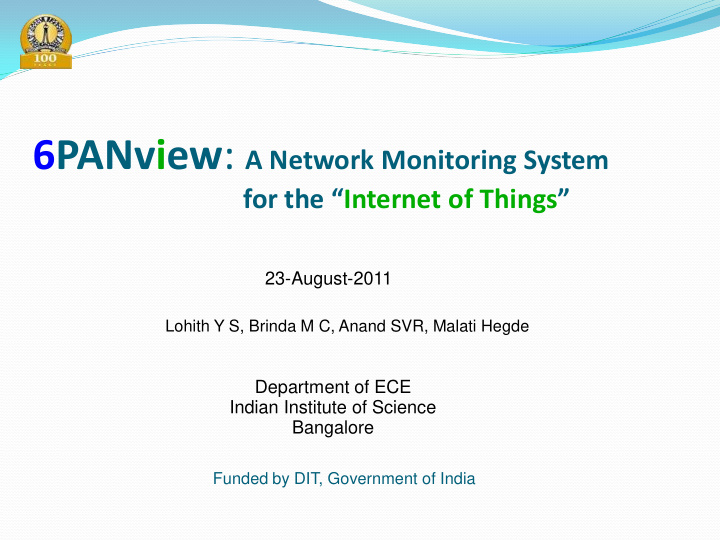



6PANview : A Network Monitoring System for the “ Internet of Things ” 23-August-2011 Lohith Y S, Brinda M C, Anand SVR, Malati Hegde Department of ECE Indian Institute of Science Bangalore Funded by DIT, Government of India
Internet of things: Next evolution of the Internet Cisco blog quotes: “ The number of devices connected to the Internet exceeded the number of people on Earth” Internet is going beyond connecting people or information sharing among them!!! Internet is now about connecting physical items i.e. M2M Communication So how the future Internet looks like ?
Let us first see the inherent challenges Deployed in unattended and not easily accessible environment Because of nature of devices and wireless medium they are inherently unreliable Operates on resource constrained low power tiny devices Limited processing (CPU, memory) Potentially deployed in large scale
What technologies make it possible? Need any new technology? Well proven IP and PAN and sensor technologies are there already Ipv6 and 802.15.4
Overview of 6LoWPAN 6LoWPAN’s Solutions Challenges Frame size issues Header Compression MTU issues Fragmentation Routing L2 and L3 routing Addressing Stateless address auto-configuration
MTU and Routing Issues
Putting it all together
RPL : Routing over Low Power Lossy Networks RPL : IETF’s IPv6 routing protocol for low power networks RPL considers dynamic characteristics of the wireless channel, and WSN node constraints Routing over rank based DODAG tree Provides application specific routing RPL is strictly compliant with layered IPv6 architecture Supports MP2P,P2MP,P2P traffic Autonomous operation :RPL nodes independently and autonomously discover network topology ,computes and install routes without administrative interaction
DAG Construction: Node multicast solicitation messages(DIS) to join the network Nodes which have the route reply to DIS by RA (DIO), also nodes periodically emitting RAs Nodes who hear RAs evaluate the OCP and other information before deciding to join the DAG Nodes join the DAG by accepting the advertised node as its parent
6PANview
WSN Monitoring WSN is expected to work “autonomously” WSN is expected to self organize and self manage Does this happen in real world deployment ? ‘Nature is unpredictable’ (Node Failures, Dynamic Topology, Disconnected Network…) Monitoring WSN network itself becomes essential
6PANview Architecture
6PANview Overview
Deploying Challenges Very limited debugging mechanisms and tools Present available stack is unstable Very less memory Simulation does not produce exact results Very less deployed networks
Ongoing work Scheduling Monitoring Activity Minimise Radio Interference caused to critical WSN applications Maintain reliability and QoS requirement of WSN applications (Industry, Healthcare) Based on the current application traffic adaptively Identify Low or Idle time intervals through traffic modelling/measurement and adaptively schedule the monitoring Query staggering to avoid congestion and improve reliability in the case of asynchronous events Master agent overlay network Master Agent Placement Separate Radio Channel Time slotted channel switching between the application and monitoring Uses different RPL instance with its own OF Caching Minimises the number of queries into the network Accuracy vs. Energy trade-off Context sensitive refresh times for monitor parameters Extensive Traffic Analysis and Anomaly Detection
Conclusion 6PANview has the potential to become one of the first efforts in the area of WSN monitoring over the Internet 6PANview system is envisaged to provide rich set of WSN monitoring statistics, trouble-shooting alerts, performance metrics, time series plots and so on 6PANview presents all these information on a user friendly java/web based GUI for WSNMS and all end users The source code of 6PANview can be downloaded from http://sourceforge.net/projects/sixpanview Visit us at http://www.ece.iisc.ernet.in/6panview
THANK YOU
Recommend
More recommend